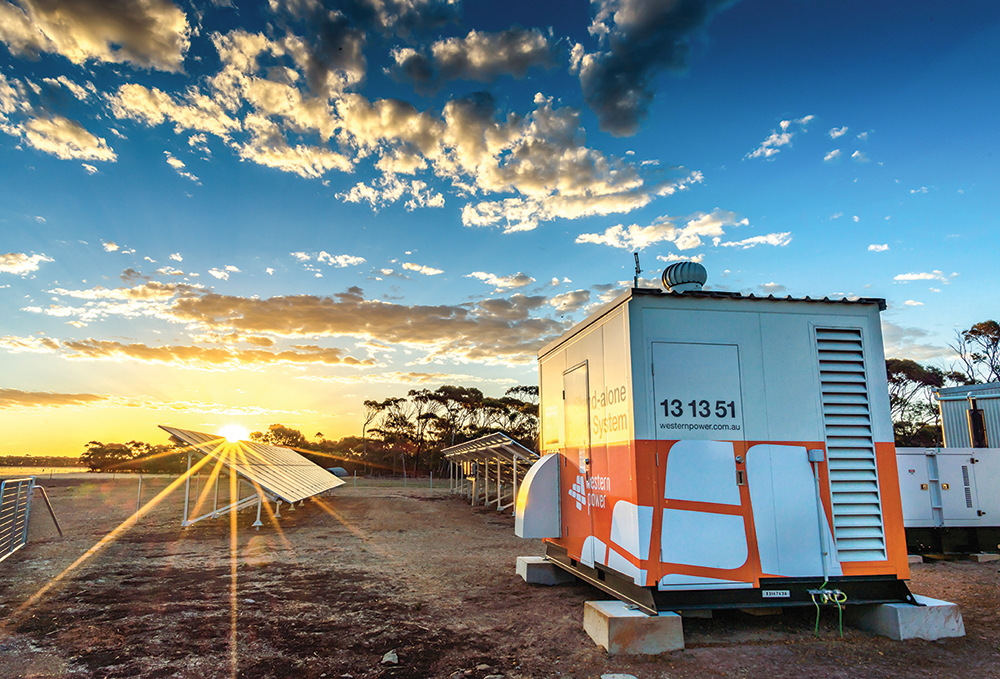Ruling out innovation?
Last week the Australian Energy Market Commission (AEMC) decided not to make a draft rule related to off-grid electricity supply solutions. Western Power requested a rule change to remove a regulatory barrier, arguing that electricity distribution services should be classified in terms of the service they provide, rather than just by ‘poles and wires’.
The current regulatory framework prevents distributors from establishing disconnected micro-grids and stand-alone power systems. This is despite the fact that, in some circumstances, an off-grid supply solution may better meet customers’ electricity service needs and be more cost-efficient than building more poles and wires, lowering costs for all network customers.
The AEMC’s media release was very supportive of the concept, noting that “installing off-grid systems, which typically include solar panels, batteries and a diesel generator, in locations where it would be cheaper than maintaining the grid connection, can reduce network costs for all consumers.”[1] However, the AEMC chose not to make the draft rule, suggesting it would be inconsistent with the National Electricity Law.
The laws, rules and state and territory legislation that apply to the energy sector can be complex. Adding to this complexity, there are a number of ways that off-grid solutions to deliver electricity services might be provided. In light of this, perhaps the AEMC’s conclusion that it is unable to resolve all contingencies that may arise if the rule change is made is not surprising.
However, in a dramatically changing energy system, the decision to avoid making a draft rule is disappointing because the rule change request sought to address a discrete set of issues – relating to existing fringe-of-grid customers only. It is a worrying example of how our inflexible regulatory regime sometimes cannot respond in a timely manner to developments in technology, leading to sub optimal outcomes for customers.
The rule change request
Western Power estimates that stand-alone power systems could be used as a more efficient service to 2,702 of its customers over the next ten years, avoiding capital expenditure of $388 million when compared to replacing existing network assets.[2] It suggests that these systems could achieve a lower cost solution than a network solution, and could also potentially provide a more reliable and safer outcome for customers and the network business.[3]
The rule change request recognised that, to invest in innovation, service providers require a sound business model. Distribution network service providers can only recover regulated revenue for services that are classified as distribution services by the Australian Energy Regulator (AER). If it is not clear that a particular asset can be used to provide a distribution service, it is less likely that innovative, more efficient service options will be undertaken.
Western Power’s rule change request sought to allow distribution networks to invest in non-network solutions only where they do so to provide a regulated service and there is no potential for competitive services to occur as there is no customer driven transaction.[4]
Western Power wanted the definition of distribution service to be amended to include non-network options, where they are used to replace, or substitute for, a network investment.[5]
This would remove uncertainty about what constitutes a distribution service and support the achievement of the National Electricity Objective[6]:
…to promote efficient investment in, and efficient operation and use of, electricity services for the long term interests of consumers of electricity with respect to price, quality, safety, reliability, and security of supply of electricity; and the reliability, safety and security of the national electricity system.
The off-grid experience
In July 2016, Western Power installed stand-alone power systems on six farms as part of a twelve-month trial to test the technology and customer experience compared to a traditional network service. Overall, the pilot returned positive results, including:
- Significant reliability improvements
- an average outage duration of 4.66 hours versus 69.59 hours had the same customer been connected to the network;[7]
- Higher customer satisfaction rating of the stand-alone system supply versus network supply;[8]and
- Evidence of resilience to extreme weather events.[9]
All of this was achieved at less than 50% of the cost to build and operate traditional poles and wires.[10]

One of the stand-alone power systems. Source: Western Power.
In light of these results, Western Power will continue to use stand-alone power systems to supply these customers for the next three years.
Communities served by Western Power do not currently fall under the national energy market framework. Electricity networks that service remote areas, in particular Ergon, SA Power Networks, Essential Energy and Horizon Power, have also identified that off-grid supply may make economic sense in areas currently covered by their networks.[11]
Incentives to innovate
Advances in technology are fundamentally redefining the way in which energy services can be provided. Continuing improvements in the capability and efficiency of distributed energy resources provide new opportunities for increasing the efficiency of electricity supply through micro-grids and stand-alone power systems.
For some customers there may be significant benefits in deploying lower cost, off-grid solutions in some regions and communities. Analysis undertaken by Energeia for Energy Networks Australia and CSIRO found that micro-grids are most likely to be cost effective in areas that are the highest cost to serve, which are also areas most subsidised under ‘postage stamp’ network pricing arrangements. These arrangements provide the same network tariff to rural and regional customers as urban customers and are often mandated by government regulation.
In urban areas, the introduction of alternative supply models such as micro-grids and stand-alone power systems may be driven by a customer response to the economic cost of the network. However, where ‘postage stamp’ tariffs or uniform tariff arrangements provide significant subsidies to regional and remote customers, off-grid solutions are unlikely to be adopted by individual customers without changes to network cost recovery frameworks and pricing.
With a flexible regulatory framework, lower cost off-grid solutions like micro-grids and stand-alone power systems could be employed by networks to optimise the total delivered costs to all customers.
What is next?
The AEMC has made a number of recommendations for the COAG Energy Council’s consideration as it progresses its consultation on Stand-alone Systems in Electricity Markets.[12]
This review represents an important step toward making the regulatory framework more responsive to technology and market developments. While barriers to pragmatic adoption of off-grid supply solutions remain in place, some customers may be asked to pay a higher price than necessary for their network services.
[1] http://www.aemc.gov.au/News-Center/What-s-New/Announcements/Recommendations-to-protect-consumers-while-enablin
[2] Western Power (8 September 2016) Rule Change Proposal – Removing barriers to efficient network investment, p. 4, http://www.aemc.gov.au/getattachment/b379bfe2-5ee0-43e5-a36c-6eef9068b05c/Rule-change-request.aspx
[3] ibid, p.3.
[4] ibid, p.13.
[5] ibid, p.3.
[6] AEMC (2016) National Electricity Rules, http://www.aemc.gov.au/Energy-Rules/National-electricity-rules
[7] Western Power, Stand-alone Power System Pilot, One year on, September 2017, p.6.
[8] ibid, p.7.
[9] ibid, p.6.
[10] ibid, p.4.
[11] http://reneweconomy.com.au/s-a-network-operator-to-trial-micro-grids-for-regional-towns-65654/ and AEMC, Draft determination, Alternatives to grid-supplied network services, pp.21-22.


